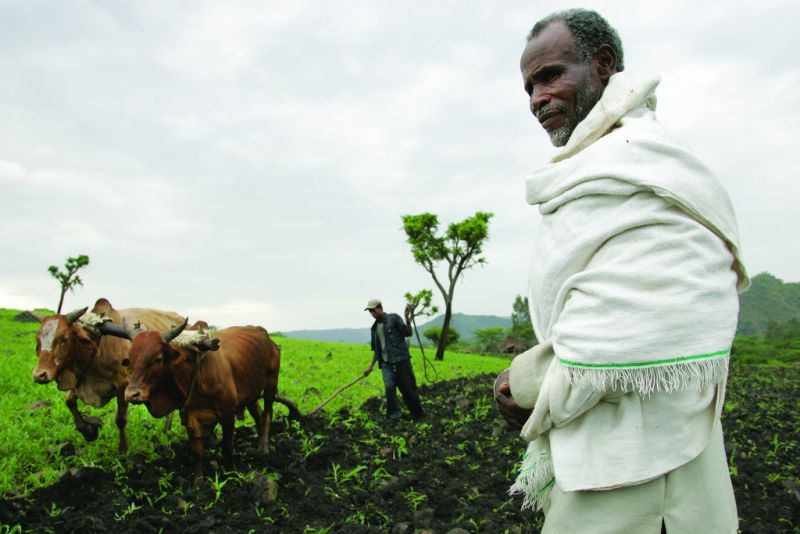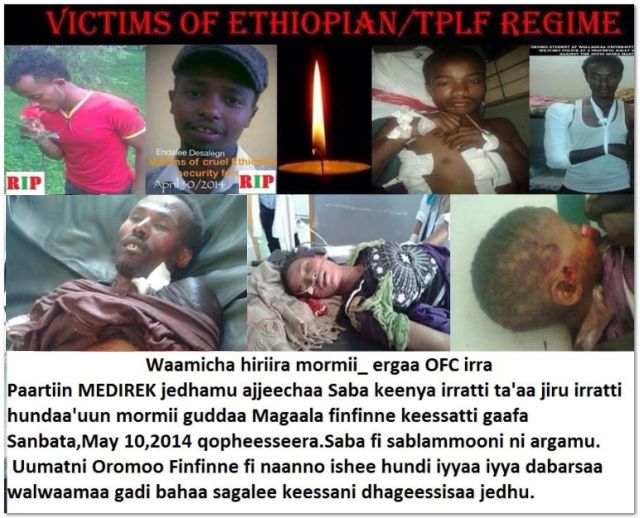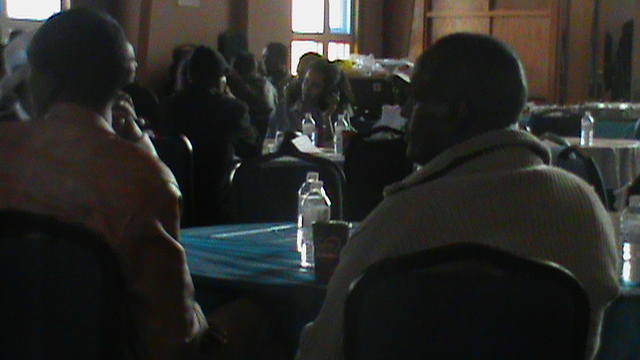 Sheikh Mohammed Hussein Ali Al Amoudi, a citizen of Saudi Arabia, spends his time shuttling between Riyadh and Ethiopia, where he was born in a village 64 years ago.
Sheikh Mohammed Hussein Ali Al Amoudi, a citizen of Saudi Arabia, spends his time shuttling between Riyadh and Ethiopia, where he was born in a village 64 years ago.
The son of a Yemeni father and Ethiopian mother, Al Amoudi boasts an estimated net worth of $10 billion. He is the richest Ethiopian and, according to Forbes, the 64th richest man in the world. Forty-five years ago, he emigrated to Saudi Arabia and built his fortune in oil refineries and the booming construction industry.
But Al Amoudi never lost touch with his homeland. In fact, Ethiopian real-estate has become a key part of his burgeoning portfolio. In 2009, Al Amoudi’s company, Saudi Star Agricultural Development, signed long-term leases for nearly 25,000 acres in the country’s northeastern regional state, Gambella, to produce rice for the Saudi market. Early in 2009, Horizon Plantations, another Al Amoudi venture, secured licenses through the Ethiopian Investment Agency to acquire a long-term lease on more than 600,000 acres of farmland in Gambella and in the Benishangul-Gumuz state in western Ethiopia—an investment some estimates put at $250 million. The Sheikh is now reportedly the largest foreign-based investor in Ethiopian land.
But Al Amoudi is not alone in seeing the vast Ethiopian plains as cheap, fertile property ripe for investment. During the past six years, as global food and oil price increases made it more expensive to import food, Saudi Arabia and other Gulf states began investing in earnest in Ethiopia and Sudan—in excess of $75 billion from 2005 to 2009, according to the Arab Organization for Agricultural Development. The largest land investor among the Gulf States, the United Arab Emirates, now controls over 1,100 square miles of farmland in Sudan.
India has also emerged as a major player in African agriculture. Last year, Ethiopia’s Minister of Agriculture, Tefera Deribew, visited India to announce his government’s intention to offer 4.4 million acres of farmland to Indian agro-enterprises. According to the government of India, the country’s private sector has already invested more than $4 billion in farmland located in other countries. The first to do so in Ethiopia was Karuturi Global, an Indian-based agri-business known primarily for producing cut roses. In 2010, it acquired a lease for 740,000 acres in Gambella to farm wheat, maize, and rice. Groups of Punjabi farmers are currently negotiating a deal with the Ethiopian government to lease 250,000 acres at astonishingly low rates—$3.60 per acre per year, for 25 to 40 years, with the first five years rent-free.
These deals are part of a land grab taking place all across Africa, a transfer of control unprecedented in the post-colonial era. According to a World Bank report released in January, 48 percent of all land deals struck worldwide between October 2008 and August 2009 involved land in sub-Saharan African countries.
The pace of acquisitions has been stunning. September, a World Bank report revealed that in 2009, some 111 million acres of farmland was acquired globally by foreign investors—nearly 75 percent of it in sub-Saharan Africa. Prior to 2008, foreign investors only acquired an average of 10 million acres per year.
Since the food price hikes in 2007, a range of investors—including wealthy food-importing nations like the oil-rich Gulf states—have been acquiring large tracts of land throughout Asia, Latin America and Africa. Seeking new ways to meet the food needs of their populations, a wide range of countries—including China, Kuwait, India and South Korea—have also invested heavily in land outside their borders, mostly in sub-Saharan Africa.
Generally, the deals do not involve outright sales. They are usually structured around multi-decade agreements that allow the government leasing the land to retain ownership while ceding practical control. These agreements are complex, and it’s difficult to characterize them as strictly private- or public-sector. In these arrangements, investment categories overlap, since governments sometimes play an instrumental role in adjusting regulatory frameworks to secure deals for the private sector.
Governments and their investing partners claim the deals will bring employment, food surpluses and economic growth to impoverished rural populations. Investor interest, however, has been directed primarily at countries with weak recognition of land rights. The deals are typically worked out in capital cities, far from the communities they affect. Indeed, local communities are usually excluded altogether from the negotiations. The problem is especially acute in countries like Ethiopia, where land is state-owned.
“All land-lease projects in the country have been carried out without any input from the Ethiopian people,” says Nyikaw Ochalla, director of the Anywaa Survival Organization, an advocacy group fighting for land and livelihood rights of farming communities in Gambella. “If the government had an interest in protecting the people from the massive environmental and economic impacts of the land grab, it would ideally open up the process to involve affected communities. This role of the local people is missing from the equation.”
Moreover, foreign investors in African farmland generally do not target existing agricultural systems—many of which are failing due to a lack of resources and the absence of agricultural policies that would protect small farmers. According to a recent World Watch Institute report, only nine African countries allot 10 percent or more of their budgets to agricultural development. And since 1980, agriculture’s share of worldwide investment has dropped from 16 percent to 4 percent. Partly as a result, developing countries increasingly depend on food aid. The tragic irony is that a substantial majority of the world’s hungry live in rural farming communities.
LOCALS IN THE WAY
Rising food prices have already limited donor countries’ ability to purchase enough food to meet aid demand equitably. The World Bank estimates that production will have to rise by 70 percent in developing countries by 2050 to meet the needs of growing populations. Investments in available farmland are creating new commercial farm ventures for foreign investors to produce food and biofuels cheaply for export. In these deals, the investors call the shots—dictating the nature, scale and implementation of projects.
That’s certainly the case in Ethiopia, the fifth “hungriest” nation in the world, according to the Global Hunger Index. Even though 80 percent of all jobs in the country are in agriculture, 13 million Ethiopians, 15 percent of the population, depend on food aid. Yet the government intends to lease 7.4 million acres to foreign investors for development by 2013—a number that doesn’t include long-term leases to ex-pats like Al Amoudi. Such a sudden and dramatic change in land ownership could result in growing numbers of internally displaced people, shorn of their livelihoods and exposed to an increased risk of poverty, malnutrition and hunger. Historically, that is a recipe for violent conflict in this part of the world.
Large land acquisitions of this kind often depend upon the massive displacement of rural populations. Last year, the Ethiopian government relocated 150,000 inhabitants of the country’s eastern Somali region. Plans calls for the relocation of more than 100,000 households in the next year, including 45,000 in the Gambella region alone, as part of the government’s Villigization Program Action Plan. The government claims those relocated will benefit from access to arable land in areas where schools, roads, and basic infrastructure are to be built.
Ethiopia’s Minister of Federal Affairs, Shiferaw Tekle-Mariam, has denied that the resettlement programs are tied to the recent surge of land leases. However, according to the Solidarity Movement for a New Ethiopia (smne), a U.S.-based human-rights group, the “villigization” program is providing cover for the government’s displacement of residents from lands leased to companies like Al Amoudi’s Saudi Star company and India’s Karuturi Global. The group claims that forced displacements have already occurred and that the government has deployed its armed forces to the region to suppress dissent. Obang Metho, executive director of the smne, says that 49 villages have already been displaced.
“Karuturi and Saudi Star will be developing more land in Gambella and as a result, more people are being told—or, as some say, blackmailed—to leave,” Metho claims. Three villages refused to do so, he says, prompting the government to resort to the use of force. (An Ethiopian government spokesman denies this.)
Karuturi Global did not respond to requests for comment. A spokesman for Al Amoudi strongly rejects the implication that Saudi Star is in any way responsible for or complicit in any alleged human-rights violations. “All leases are taken up in accordance with Ethiopian law and in accordance with Ethiopian government policy,” the spokesman notes.
The spokesman also says that Al Amoudi’s investments will improve the quality of the land and that the Sheikh is “investing heavily in the local community and is committed in principle both to transferring technology to local farmers and to purchasing their crops for market on fair terms.”
COLONIAL ECHOES
Barely 20 percent of these land-investment projects have reached an operational stage, so it remains difficult to assess their social, economic and environmental costs and benefits. Even once they launch, it may be difficult to measure their efficacy or impact. Given the significant potential consequences and the size of the investments involved, there exists distressingly little information about exactly how these deals are done—or who, exactly, does them. Investment procedures are shrouded in secrecy, and the identities of many investors remain unknown.
Last October, a study conducted by the Center for Human Rights and Global Justice at New York University School of Law surveyed private investment in agriculture in Sudan, Pakistan, Tanzania and Mali. The study found a near-total lack of transparency and noted the absence of regulatory frameworks within the host countries that could reliably scrutinize projects. The report also found evidence that these investments left displaced people, food insecurity and water shortages in their wake. Pakistan, for example, has announced its intention to make six million acres available to private investors, which threatens to displace 25,000 villagers.
Not surprisingly, a great deal of the land being gobbled up is located in agriculturally depressed, politically unstable, conflict-prone nations that have poor records when it comes to the formal recognition of land rights. In places like Angola, the Democratic Republic of the Congo, Sudan and Mozambique, farmers and rural agricultural workers have been historically denied equal access to resources. The land grabs unmistakably evoke the colonial era, when great powers carved up the globe and appropriated land and natural resources at will.
Nyikaw Ochalla, the indigenous-rights advocate, views the practice as “internal colonialism,” citing the state’s complicity in seizing its own citizens’ land for foreign investors. “Most of the areas targeted by foreign agricultural investment companies have had limited influence on central authorities,” says Ochalla. “The scale of the land deals, which do not involve local residents in the process, will affect the traditional way of life and prevent locals from owning important assets.”
Yet it is not only wealthy countries and private investors that are driving the contemporary land grab. India has become a major buyer of foreign farmland. The country is the second-largest wheat producer in the world and has been self-sufficient in food-grain production since the Green Revolution in the 1960s and 1970s. With 60 million tons of surplus food grains this year, India currently has enough to feed its people. But inadequate support for small farmers and a public food distribution system ravaged by corruption have diminished access to food for many of India’s 230 million hungry people. India’s current hunger crisis is not an issue of supply, but an issue of access. Still, India’s growing population is leading officials to plan for supply shortages in the near future.
That’s why Ethiopia has become a prime target for Indian agri-businesses. In the Gambella region, four Indian firms signed long-term leases on nearly 890,000 acres of farmland in less than two years. Besides Karuturi Global, Sannati Agro Farm Enterprise acquired 25,000 acres for 25 years (reportedly for around $9.50 per acre), to produce cereal and rice. Ruchi Soya now controls just over 60,000 acres for soybean production. And BHO Agro Plc acquired 66,700 acres for biofuel production.
The Indian government doesn’t currently offer financial support to investors eager to invest abroad, but foreign land-acquisition has found a number of advocates within the entrepreneurial elite driving India’s economic rise. They argue that such investments are win-win. As Rana Kapoor, the CEO of India’s Yes Bank and a member of the government of India’s Board of Trade, recently wrote, “The production from these farmlands can supplement the food supplies of India while addressing local food security of the host country. In addition, these investments have the potential to benefit host countries through the transfer of investment and advanced technology into these developing economies.”
But do these investments create employment opportunities for rural populations? According to the September World Bank report, only one job has been created in the Horn of Africa for every thousand acres of agricultural land acquired by investors. “Much of the investment is speculative,” says Klaus Deininger, lead economist at the World Bank’s Development Economics Group and the report’s author. “Employment generation did not happen and smallholder access did not happen. Many of the local people are getting a bad deal.” Deininger notes that, in Ethiopia, the government has pledged to create compliance mechanisms to address the problems that arose from the first wave of land deals. “But the policy regime is very deficient,” he observes. “The land is expropriated from the poor, and there is little potential for them to get compensation. The poor are subsidizing the rich.”
Deininger explains that since many of the targeted countries don’t have functioning land markets, it will be nearly impossible to liquidate enterprises of this kind that fail. Consultations are now underway between the World Bank and host country governments for new compliance mechanisms which will allow existing legal frameworks to undo bad investments. This is necessary, Deininger notes, since only 15 to 20 percent of all agribusiness projects succeed. “If 80 percent of these ventures are unsustainable,” he says, “you’ll need strong compliance standards where small holders can still benefit.”
THE RIGHT TO FOOD
In addition to doubts about whether large-scale foreign control of agricultural land will create jobs for locals, some opponents of the practice view the land offerings as an inherent violation of rural peoples’ right to food. The international right to adequate food is articulated in General Comment No. 12 of the U.N. Covenant on Economic, Social and Cultural Rights. One hundred sixty-seven states are party to the covenant, which entered into force in 1976.
In the 1990s, the international community recognized the urgency of implementing the specific right to food—an amendment to Article 11, the right to livelihood and shelter—into domestic laws in the context of national food security programs. In 2004, 187 member states of the General Council of the United Nations Food and Agriculture Organization (FAO) adopted voluntary guidelines on introducing the right to food into national constitutions. Countries that have enshrined the right to food choose how the right will be defined, respected and enforced in line with national laws. Currently, 24 countries have done so.
As a signatory to the U.N. covenant, India recognizes a legal right to food. In 2001, a severe drought year, the state of Rajasthan witnessed starvation deaths while food-grain surpluses (totaling 50 million tons that year) literally rotted in public storage facilities throughout the country. Media reports outraged the public and resulted in a sustained right-to-food campaign. In the wake of this national scandal, India’s Supreme Court ordered individual states to uphold the right to food through social programs. In response, states instituted a variety of programs: subsidized midday meals for children, rural employment schemes guaranteeing 100 days of work to laborers, and the appointment of health workers in villages throughout the country to care for children and nursing mothers. A comprehensive National Food Security Bill is expected to go to a vote soon. If the bill passes, it could assure the poor an actionable right to food and corresponding rights to land and water.
This could leave India open to the charge of hypocrisy—recognizing its own people’s right to food, while contributing to the denial of that right in countries where Indian companies have acquired vast swathes of farmland, forcing locals from their farms and livelihoods. Will the Indian government hold Indian agro-enterprises accountable if their activities abroad contribute to the abrogation of the right to food?
AIDING…OR ABETTING?
The African land grab is primarily a bilateral affair, carried out in deals between two states or between states and private investors. But a powerful international institution is also facilitating the process—the World Bank. Through two of its private financing arms, the International Finance Corporation (IFC) and the Foreign Investment Advisory Service, the World Bank helps private investors obtain land in African countries.
According to Anuradha Mittal, executive director of the Oakland Institute, a think tank in California, the IFC has facilitated the acquisition of land in ways that are harmful to local populations. By setting up advisory services and investment promotion agencies, it has allowed private firms to obtain insurance and establish water rights. In countries like Mozambique, where the state owns the land, a formalized process has been set up through the advisory services. But the country faces pressures to make itself “investor friendly” and this results in a process marked by a lack of governance and consultation with local communities.
Since 2000, the IFC has trained bureaucrats in the Ethiopian Investment Agency on how to promote foreign investment through workshops on market rating and land appraisals. Both World Bank institutions have expanded since 2001, and their combined expenditures jumped from $167 million in 2003 to $1.8 billion in 2009. In April 2010, the Oakland Institute issued a report on the World Bank’s involvement in the land deals, arguing that by rewriting investment laws and creating land registries for large investors to promote access to land markets, the World Bank is, in effect, abetting the displacement, impoverishment and food insecurity of the very populations its agricultural policies are designed to help.
“There is clearly a need for compliance and transparency,” admits Klaus Deininger, the World Bank economist. “The IFC is currently revising compliance laws to prevent shady deals in the future.”
THE COMING YEARS
Large-scale agricultural investment in Africa is likely to become a fixture of international relations in the coming decade. For that reason, a consensus is emerging that it might be best to reform the model, rather than prevent its use entirely. “The idea that large-scale foreign investment into agriculture is either all good or all bad is not true,” says Dan Gustafson, director of the North American office of the U.N.’s FAO, in Washington. “We have to look at the complexity in a sophisticated way.”
Gustafson and others argue that countries and investors should be encouraged to adopt mixed agricultural models that hold investors accountable for boosting smallholder productivity and ensure community shareholder equity. In cases where investors and host governments cannot ensure those conditions, investments should be rejected outright. To realize this goal, however, policymakers will have to take bold steps to hold states and large investors accountable and enforce the right to food under national law—especially in countries that have adopted the U.N. covenants. This requires states to adopt legal frameworks specific to the right to food, which would ensure actionable rights for citizens. Nicaragua, Bolivia, and Guatemala have already adopted such frameworks; Brazil, India, Mozambique, Malawi, and South Africa are gearing up to do so.
In another encouraging development, the G-20 countries have pledged $20 billion to fund agricultural development initiatives in developing countries through the World Bank’s Global Food Security and Agricultural Program. Proposals are written by the donor-recipient countries, a practice that reforms the top-down approach of international-development policies. Ethiopia has already received $51.5 million dollars for the program. Niger and Mongolia have received $33 million and $13.5 million, respectively.
Both approaches—the human rights framework and the reform of agricultural development models—are responses to an international consensus that the recent food crisis is unsustainable and must be tackled through better governance by states and better practices by international development agencies. Countries and development agencies that fund their agricultural programs must ensure small farmers’ rights to land and food. Otherwise, the dark side of the current land grab will be its only side.
Ashwin Parulkar is a South Asia analyst for Freedom House and previously served as a consultant for the International Food Policy Research Institute.
[Image courtesy of International Livestock Research Institute.]

















